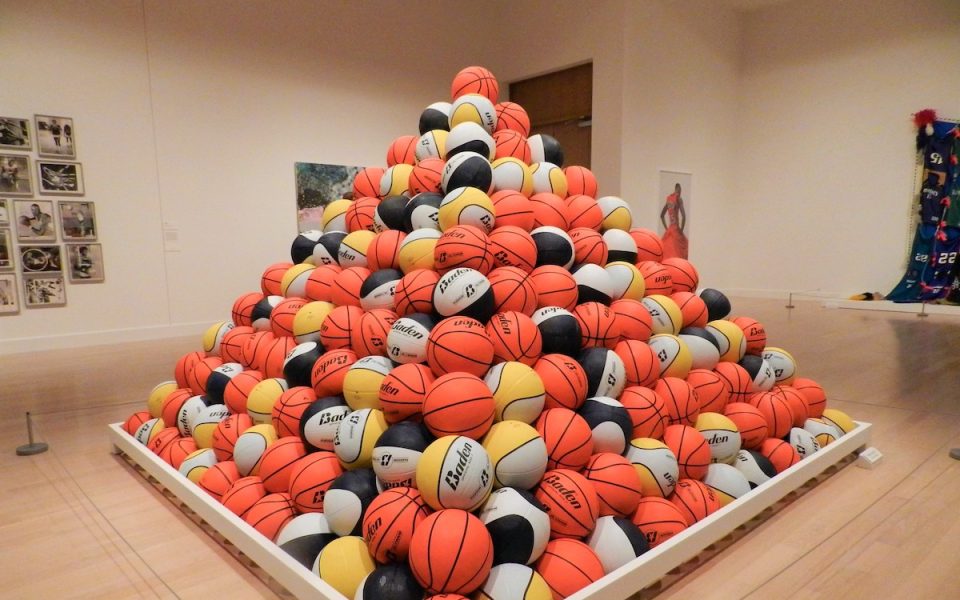The
basketball sits suspended and immobile.
It
levitates at the center of a large water tank, the orange rubber refusing to
bob up or sink down in the cool, blue liquid. The only movement is on the
surface, a barely noticeable ripple in the salt water.
The
work — “One Ball Total Equilibrium Tank” by Jeff Koons — joins dozens of others
in the Weatherspoon Art Museum’s latest exhibition, To the Hoop. The museum’s second-floor gallery houses a selection
of artworks revolving around the sport of basketball, and its history as part
of American culture.

“Basketball
is the universe here,” curator Emily Stamey says.
On
a Friday night, Stamey welcomes guests during the exhibit’s opening. Stamey
herself gained a love of basketball during graduate school at University of
Kansas, even studying Koons’ piece at one point.
The
sport traces its roots back to James Naismith in 1891, who used peach baskets
and a soccer ball to devise an indoor, winter sport for the instructors of his
local YMCA in Springfield, Mass. A year later, Senda Berenson created a women’s
version of the sport for Smith College, and the game then spread across America
in less than half a century.
People visiting the gallery for the opening don jerseys of their favorite teams, sneakers and shorts. The smell of rubber from basketballs used in the art pieces, combined with the sounds of sneakers on the wood-panel floors, make the gallery feel more like a court.

Antonia Smith, a UNCG alum, stands by a cutout of the Jumpman logo, altered to have a third leg — a symbol of basketball fans’ tendency to focus more on the men’s teams. Smith, along with other visitors, walk through their exhibit remembering their own childhood basketball games, and came to celebrate the connections and community around the game.
“I
like how it brings people together,” she said.
Within
the gallery, it becomes clear how accessible the game itself is. With no fancy
or expensive equipment required, and no formal uniform or safety gear, the
image of a backboard on a telephone pole feels as important to the sport as a
photograph of an NBA match. A set of screens on one wall shows a dribbling
instruction video. Hidden away in a corner, another screen shows a loop of a
man in a Lakers-themed hoop skirt, trying to shoot baskets. A couch sits in
front of it, barely empty for a moment during opening night as guests stop and
enjoy a game together.
-

Victor Solomon’s “Church” makes a backboard look like something out of a cathedral (photo by Savi Ettinger) -

“This Will Not Be Alright” by Brian Jungen ties dozens of Nike Air Jordans together (photo by Savi Ettinger) -

In “Well Hung,” Suzanne McClelland spotlights WNBA jerseys (photo by Savi Ettinger)
For
the show, Raleigh artist André Leon Gray contributes a work entitled “Black
Magic,” referencing the significance of the sport in black American
communities. In 1904, the game was introduced into segregated schools of
Washington, DC by a black gym teacher, Edwin Bancroft Henderson. In 1923, the
first black professional team, the Harlem Renaissance Big Five, formed within
30 years of the first time the sport was ever played professionally.
A
wooden ironing board hangs on the wall, a basketball haloed by black and red
wires on its top. Below, rhinestones form the shape of a veve — a symbol used
in Haitian Vodou. Continuing with the Vodou aesthetics, the board turns into a
mask at its tapered end. Where the forehead of the mask would be sits a
sweatband with the iconic silhouette of Michael Jordan in the air.
“If
you think about it,” Gray said, “there’s all these players defying gravity and
doing these magic moves.”
Throughout
the gallery, the line between basketball and the metaphysical blurs. Pink balls
are carved open to reveal they’re actually rock geodes. Jerseys continue into
skirts, forming ballgowns in team colors. A stained-glass backboard casts
yellows and reds over a corner of the room. In the center of everything, an
imposing pyramid of basketballs overlooks the gallery.

The
classic orange beside UNCG’s own navy blue and gold draws the eye. The work —
the fifth basketball pyramid by David Huffman — hides speakers at its core,
filling the space with sounds from games past. Here and now, they act as a
centerpiece.
When
the exhibit ends, the screens will be taken down and the paintings and
photographs will get removed from the walls. However, each of the balls will
find a new home, in a youth rec league or YMCA. They will find a new court to
be played in, and the game continues.
“These,”
Stamey said, “will go out into the community.”
For more information on To The Hoop visit weatherspoonart.org. To the Hoop runs from Feb 1 until June 7.
Join the First Amendment Society, a membership that goes directly to funding TCB‘s newsroom.
We believe that reporting can save the world.
The TCB First Amendment Society recognizes the vital role of a free, unfettered press with a bundling of local experiences designed to build community, and unique engagements with our newsroom that will help you understand, and shape, local journalism’s critical role in uplifting the people in our cities.
All revenue goes directly into the newsroom as reporters’ salaries and freelance commissions.


Leave a Reply